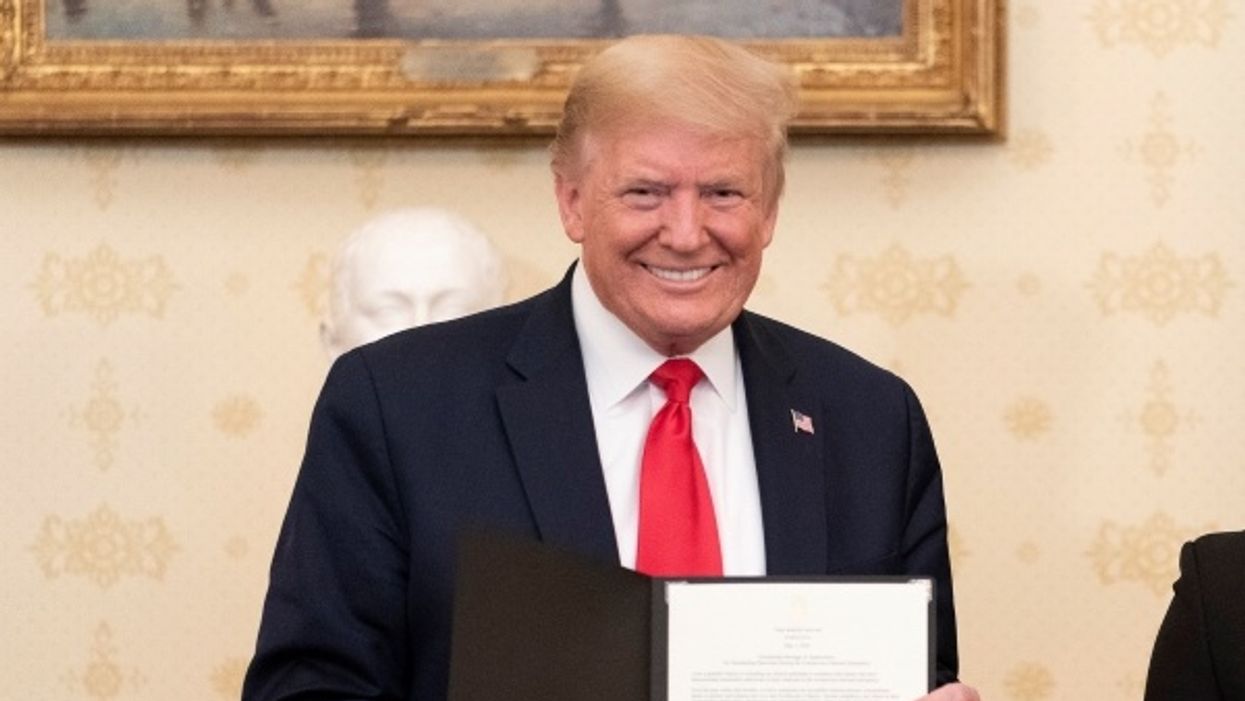
Reprinted with permission from Alternet
A new interview of President Donald Trump with Axios' Jonathan Swan garnered much attention and acclaim for the reporter on Tuesday, with many stunned at the level of ignorance, incompetence, and callousness on display in the White House.
But to be frank, while Swan put up some resistance to Trump and fact-checked him at key moments, he actually let the president get away with a lot of lying and dishonest spinning. Of course, this is what the president does — he spews disinformation and tries to bulldoze anyone who challenges him — which makes him difficult to interview. Much of it made Trump look ridiculous and incompetent, but that was often more Trump's doing than Swan's.
There was one particular exchange, though, where the combination of Swan's pushback to Trump's lies and the president's fumbling for an explanation was deeply revealing about his administration and the place the country finds itself. Trump boasted about the amount of coronavirus testing the United States has done, but Swan accurately pointed out that such extensive testing is only necessary because the virus is so widespread. And then Swan tried to steer the conversation toward the most important statistics.
"The figure I look at is death. And death is going up now. It's a thousand a day!" Swan said.
"Take a look at some of these charts," Trump said, bringing up a pile of papers. "Right here: United States is lowest in numerous categories."
"In what?" Swan asked. "Oh, you're doing death as a proportion of cases. I'm talking about death as a proportion of population. That's where the U.S. is really bad. Much worse than South Korea, Germany, etc."
"You can't do that!" Trump responded.
Swan looked puzzled. "Why can't I do that?"
"You have to go by the cases," Trump said.
"It's surely a relevant statistic to say if the U.S. has X population and X percentage of death per that population, vs. South Korea," Swan argued.
"No, because you have to go by the cases!" Trump demanded, becoming petulant.
"Well, look at South Korea, for example: 51 million population; 300 deaths. It's crazy compared to—"
"You don't know that!" Trump interjected. He then tried to cast doubt on the South Korean statistics.
This move, of course, gave away Trump's strategy. He wants to draw a direct comparison to other countries when he thinks it reflects well on him. And when the question is abstract — whether we care about the percent of deaths per case or per population — he can just assert that his preferred metric is correct. But when Swan cleverly cast the question in concrete terms that showed how much more successfully South Korea has contained the virus, Trump needed to shift the ground of his argument and question the validity of the statistics that he had just based his case on.
He then tried to get Swan to praise him for the large number of tests the United States conducts — even though, as Swan had pointed out, it only conducts so many tests because the outbreak is so bad. And indeed, the country is almost certainly not conducting as many tests as it should, because the high positivity rate of the tests in recent weeks suggests that many cases are going undetected.
What was most revealing about the exchange is how uninterested Trump actually seemed in the life and death stakes of the matter, or in getting the science right. He's not concerned, as I've shown, in having a serious debate about which metric is most meaningful for understanding the nature of the pandemic in the United States. He's only interested in focusing on which statistic he thinks makes him look good. Any news that doesn't make him look good is dismissed as irrelevant or fake — that's why he whined "you can't do that" when Swan cited deaths as a proportion of the population. Trump has no argument for why this statistic was spurious or misleading, and surely it's not, because it's the federal government's responsibility to keep the virus from spreading in the United States. It has utterly failed to do that, and more than four million cases and more than 150,000 deaths are the results.
Trump earlier showed his callousness when Swan pressed him on the daily death rate of more than 1,000 a day: "They are dying, that's true. It is what it is."
And later, on a totally different subject, Trump showed his willingness to pick and choose types of data to fit the narrative he wants to push.
"Why do you think black men are two and half times more likely to be killed by police than white people?" asked Swan.
"Police have killed white people in a larger number," Trump said. "Police have killed many white people also."
So there, Trump dismissed proportionality entirely as a relevant metric for police deaths and instead just looked at the total numbers. If he had focused on totals rather than proportionality in the case of coronavirus deaths, of course, he would find that the United States has — by far — the greatest total coronavirus deaths in the entire world. But that number doesn't fit his narrative, so he ignores it.
- Trump Will Make Super Bowl Appearance With Hannity - National ... ›
- In ABC Interview, Trump Says Article II 'Allows Me To Do Whatever I ... ›
- Trump Questions Lincoln's Legacy In Bizarre Fox Interview ... ›
- #EndorseThis: In Axios Remix, Trump Loses Argument With Himself - National Memo ›
- VIDEO: Trump’s Most Cringe-Worthy Moments Of 2020 - National Memo ›
- #EnodrseThis: Kimmel Says Maybe Trump Should Quit Making Phone Calls - National Memo ›
- How To Answer The Criminal Delusions Of Donald J. Trump - National Memo ›








